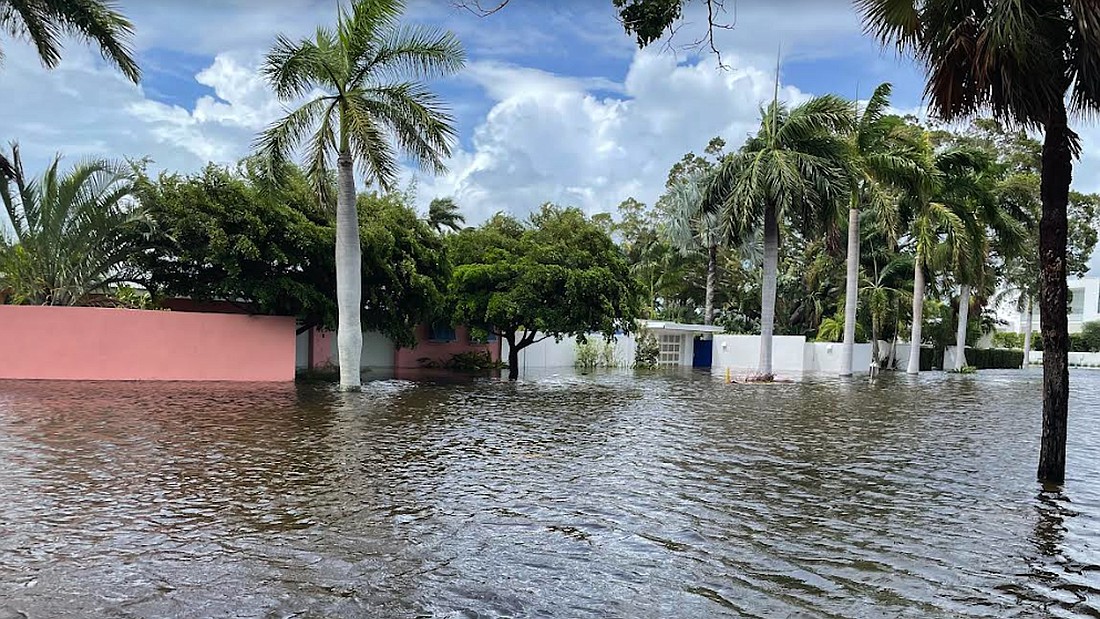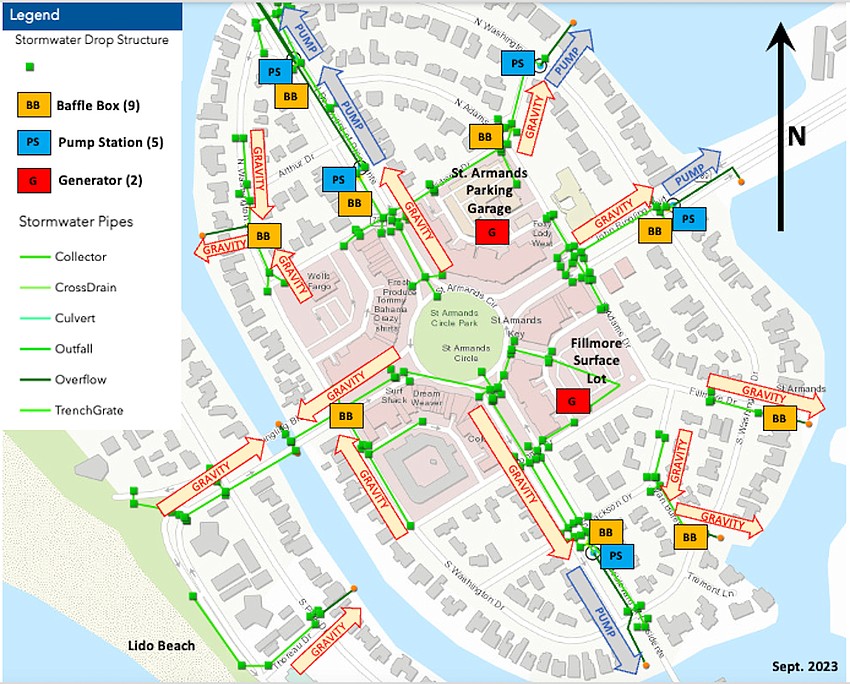- May 1, 2024
-
-
Loading

Loading

Oblong and concave, St. Armands Key is like a giant bowl that can fill with water during heavy rains and storm surge events.
That’s why buried beneath the stylish surface of the commercial district in the center of St. Armands and the tony residential neighborhood that encircles it is a pump and drainage system designed to remove excess stormwater and send it into the Gulf of Mexico.
The drainage system, which was installed and is maintained by Sarasota County via interlocal agreement with the city, is designed for a 25-year event — 9 inches of rain within 24 hours.
Although it passed Sarasota well offshore, Hurricane Idalia brought conditions that far surpassed the 25-year event standard. The storm dealt St. Armands Key battering westerly winds combined with not only a high tide, but a king tide — an infrequently occurring exceptionally high tide. That combination breached seawalls around the key, overwhelming the system.
It was literally, Sarasota County Public Works Director Spencer Anderson said, “a perfect storm.”
In the aftermath, businesses on St. Armands Circle were left with more than a foot of water on the streets and some water breaching their buildings. There was more severe street flooding on the north end as police closed off access to the key until the bowl could be emptied. That left merchants and residents alike wondering why the pump system failed, and how such a failure could be prevented in the future.
Installed in 2008, the active drainage system, Anderson said, has performed as designed. Idalia, though, demonstrated weaknesses in the system, which are in the process of being addressed.

Chief among those weaknesses was the electrical system failing when the control panels became submerged in sea water.
“When the project was originally constructed, there was significant demand by the community to make the system as low profile as possible,” Anderson said. “We did that and mounted the electrical control panels fairly low to the ground, and we found out that's not a good idea. We are looking to raise those electrical panels to a higher elevation to hopefully avoid a similar flooding of those electrical components in the future.”
The system rendered inoperable, the county dispatched crews and temporary equipment to pump the trapped water out. Those pumps will remain in place until the electrical panels are replaced and other repairs are made.
“The long lead-time item are the electrical panels that were submerged,” Anderson said. “They do take some time to manufacture, so we expect that within about 90 days we'll have the system back up and running as it was prior to the storm.”
Soon after the storm ended, St. Armands Residents Association President Chris Goglia was in communication with city and county officials about the conditions there. Spending the summer at his second home in Rhode Island, he received emails from about 10 residents about conditions they found once they were allowed to return to their homes.
One homeowner, he said, had to leave his vehicle and walk several blocks to his house, wading in thigh-deep water, where he found 6 inches of water throughout his home. After he opened his front door and garage to begin drying out the home, a pickup truck drove by, Goglia was told, literally sending a wake into the house.
“He had the foresight to put some of his furniture up on blocks and he was able to save a lot of his furniture having done that,” Goglia said. “But he said all his appliances are gone. The drywall has got to be taken out two feet above the floor and replaced. He said he's still waiting for the final number from his insurance adjuster, but he suspects it's going to be north of six figures.”
The man’s home, Goglia said, is located on the northeast quadrant of the island, the low point that experienced the worst flooding.
That's near the location of first, and for a while only, pump station at the intersection of North Washington Drive and Madison Drive. That was the only pump in operation on St. Armands prior to the project to install the islandwide system in 2008 to 2009.
“I don't know when it was installed but that is the lowest part of the island,” said Anderson. Coincidentally, that station also happened to be damaged by a vehicle crash the night before Idalia and was not operational.
“A temporary pumping system was installed early Wednesday morning, however it was impacted by flood waters during the storm later that day,” Anderson said. “Once flood waters receded enough to allow personnel to access the station late Wednesday, the temporary pumping system was restored and flood waters were pumped down by Thursday morning.”
The area around that original pump station has been an ongoing source of issues, according to Goglia. While perhaps not related, that area was the site of a small sinkhole in the road in 2020. And, Goglia said, there is consistently a rancid odor around that intersection.
“Just walking around with my family over the years, there's always an odd smell coming out of the ground where this pump is,” Goglia said.”We've always referred to it as 'smelly corner.'”
Since Hurricane Idalia, Goglia has been in frequent communication with Anderson, seeking details of how the pump system failed, whether the system was even adequate to handle a seawall overflow and, if so, how to prevent it from happening again.
“Could it have been prevented? And even if the answer is no, that’s fine. The more important question is what can be done to keep it from happening again in the future or minimizing the impact in the future?” Goglia said.
Like any coastal community at sea level, St. Armands is perennially prone to high-water events not only from storm surge, but also heavy rains. The pump station system provides a measure of protection, Anderson said, but is not equipped for waters overtopping seawalls located behind private residences.
Lido Key provides a measure of protection from a surge, but resulting rising water surrounding the island brings flooding.
“This was a unique event, a perfect storm as far as tidal conditions, wind direction and surge, and it resulted in a flooding condition that the system was not designed to provide protection against,” Anderson said. “This system actually does protect as it was designed to do fairly well. There are very few flooding events on the island compared to what it was prior to it.”
Although more recently built homes on residential streets are elevated above flood stage by code, as many as half of the approximately 200 residences on St. Armands are original, one-story, mid-century homes built on slabs at ground level.
The highest elevation on St. Armands is 3 feet.
“Now you have to build up, and that's good government at work, recognizing there's a problem and making sure people build in such a way where they're not affected by this,” said Goglia. “Maybe 30 years from now they'll all be built up, but they're not right now and so a lot of people suffered from this event. It’s one thing to say the storm surge coincided with a king tide and therefore the water came over seawalls and flooded the island. But no one has been able to tell me how they’re going to deal with it.”
Or, perhaps everything that can be done has been done.
“It’s got two design criteria," Anderson said of the drainage system. "One is for no structure flooding during a 25-year event, which is 9 inches of rain in 24 hours; and no street flooding for a three-year event, which is just over 2 inches of rain in a certain period of time. Those are the things that it could be reasonably designed for.
"Any storm event beyond that was expected to overtop the seawalls, because they're so irregular around the island because they're all individually owned by the property owners.”